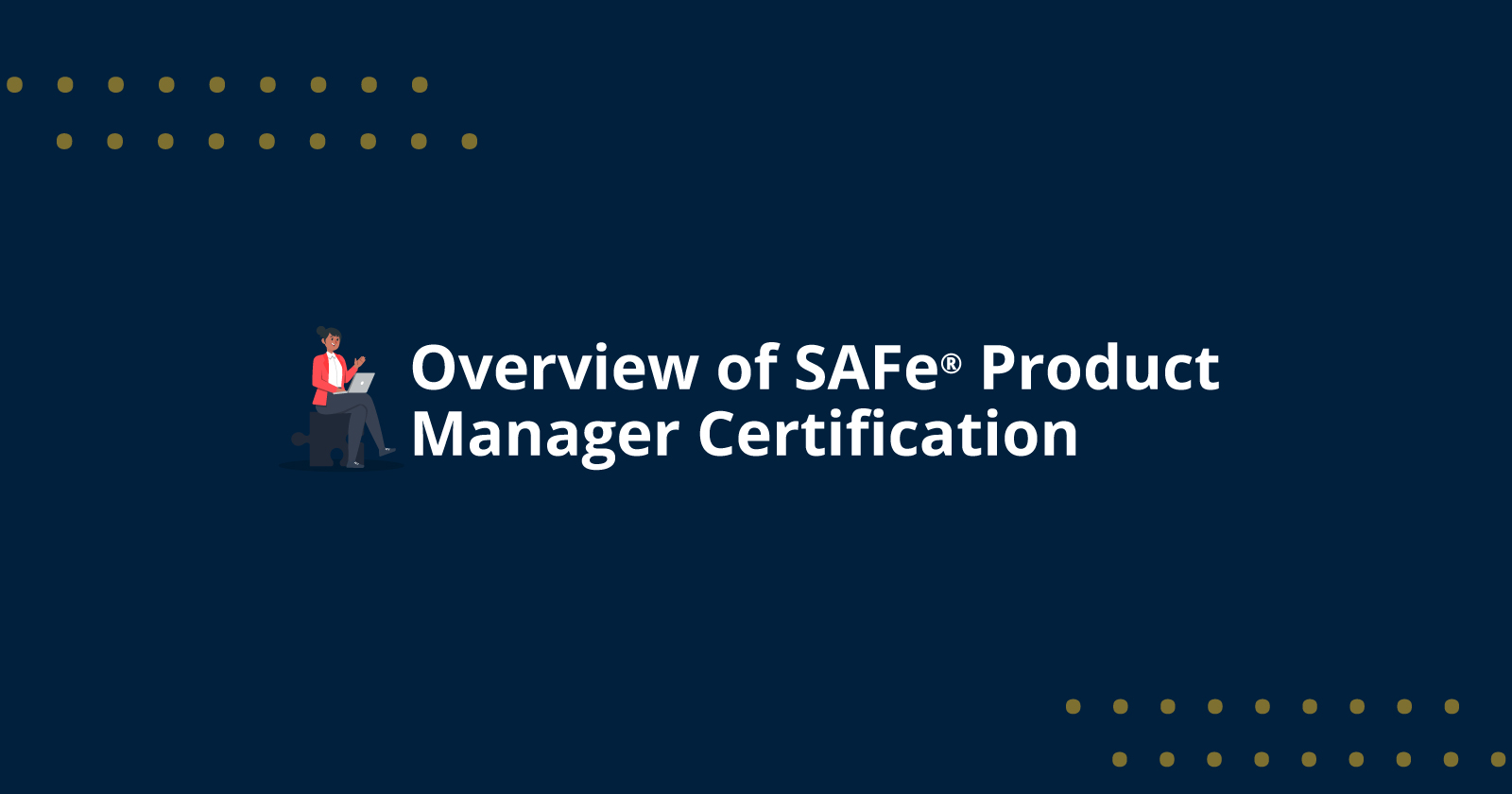What is SAFe Product Manager Certification?
SAFe Product Manager Certification is accredited by Scaled Agile, Inc. This course is particularly designed for professionals who want to gain an understanding of different kinds of processes, mechanics, and upgraded tools & techniques for handling product Managers’ responsibilities. This certification equips candidates to align products with customer needs and enterprise objectives. It's an integral part of the SAFe® framework that allows for scaling Agile techniques across larger organisations. Instead of a traditional job role for product managers, the SAFe Product Manager collaborates with different groups and programs. Their responsibilities include managing product backlogs, working together with Agile Release Trains (ARTs) and making sure value is delivered on a large scale.
This certification takes you through the importance of Lean Portfolio Management and the research of markets, forecasting financials, and stakeholder engagement. The course helps professionals connect the gap between strategy and implementation in an organizational setting by applying Agile concepts. Participants who take the POPM training will be able to master creating program increments (PIs) and creating features and using Lean methods to develop customer-centric strategies.
Professionals who are certified can collaborate with engineers, system architects & business owners in order to create value that aligns with the long-term business goals. The SAFe Product Owner or Product Manager program typically ends with an online exam. If they pass, they are awarded the certification of SAFe Product Manager and demonstrate their ability to perform the role of strategic leader in agile organizations. This certification is a great option for individuals who are looking to advance into roles that require emotional empathy for customers, data-driven decisions, and inter-functional collaboration.
What are the skills covered in the SAFe Product Manager Certification?
Here are some of the key skills that are covered in the SAFe Product Manager (or POPM) Certification Training:
1. Apply SAFe in the Lean Enterprise
- Learn and apply how to implement the Scaled Agile Framework (SAFe) within the entire organization
- Team members and other stakeholders should be aligned to achieve common goals by applying Lean-Agile methods
- Develop products and focus on delivering quality constantly
2. Identify Customer Needs
- Properly utilize customer interviews, market research, and design thinking tools
- Develop empathy maps and create personas to identify the real issues and expectations
- Transform customer insight into functional solutions
3. Develop a Stakeholder Engagement Plan
- Find the key stakeholders in both technology and business
- Establish a communication and collaboration strategy that ensures that there is a common goal
- Regularly engage with stakeholders to discuss the progress made, collect feedback, and control expectations
4. Identify Components of the Scaled Agile Framework
- Know the key SAFe roles, events, and artifacts
- Understanding aboutAgile Release Training (ARTs) Value Streams and Program Increments
- Know how your position as a product manager fits within the overall SAFe structure
5. Execute Program Increment (PI)
- Create the features, assign backlog items priority, and participate in the PI planing
- Join Agile teams to agree on the goals set and maintain alignment
- Monitor progress on delivery and monitor the process during the course of the PI
6. Lean-Agile Principles Integration
- Apply the principles that underlie Lean, Agile, and SAFe in the development of your product
- Make sure to emphasize continuous learning, quick feedback loops, and repeatable implementation
- Facilitate decentralised decision-making, and empower agile teams
Roles and Responsibilities of a SAFe Product Manager
SAFe Product Managers play an important role in directing business across the organization. They are in charge of defining the goals of the product and setting priorities clearly that are aligned with the business objectives.
The primary duties of these employees are:
- Strategic Alignment: Work closely with the stakeholders to align the roadmap for product development to the corporate strategy
- The Customer-Centric Model: Make use of the customer's feedback, analytics and market research to help inform decision-making about products
- Backlog Ownership: Manage and prioritize the backlog of your program in order to direct Agile Release Trains (ARTs)
- Definition of Feature: Transform the business requirements into usable elements and assist the development teams
- Programming Increment (PI) Plan: Take part in the PI planning process to ensure the readiness of your feature and align it with the goals
- Collaboration: Work closely with Owners, System Architects, UX, and other key stakeholders
- Value Delivery: Track the metrics and feedback in order to make sure that functions deliver on their promise to provide business benefit
Key Benefits of Earning the SAFe Product Manager Certification
This certification also enables smoother adoption of the SAFe® framework by ensuring that key product roles are staffed with knowledgeable professionals. Here are the benefits:
- provides a thorough understanding of the Role of a Product Manager
The course offers a detailed overview of a product manager's duties within an SAFe® setting, which makes it easy for those with all backgrounds to understand the basics and gain confidence in their role.
- Learn to operate in complex, scaled Agile Workplaces
Find how to co-operate across several Agile teams, control backlogs, and create an alignment between the strategies and actions for large-scale organizations. - Provide customer-centric solutions
Utilize methods to determine customer requirements and prioritize features efficiently to deliver solutions of high value that are in line with company objectives and expectations of the customer. - Learn about SAFe®and agile Methodologies
Establish a solid understanding of the lean Agile principle and SAFe®techniques. This helps you communicate better with other stakeholders and increases your capacity to be a valuable contributor to organizations that are Agile-driven. - Increase Career Potential and Credibility in the Professional World
Acquiring the SAFe®product Manager certification, an internationally recognized credential for your resume, allows you to be noticed in the market for jobs and even pursue more advanced positions in companies that are agile.
Who Should Take the SAFe Product Manager Certification?
The SAFe Product Manager Certification is ideal for professionals working in or moving toward roles that require enterprise-level product leadership.
Ideal candidates include:
- Product Owners
- Portfolio Managers
- Business Stakeholders
- Program Managers
- Product Manager
- Business Analysts
- Release Train Engineers
- Product Managers
- Agile Coaches
- Solution Managers
SAFe Product Manager Certification Process
Attend the Training: Participate in the 16-hour SAFe Product Manager (POPM) interactive training sessions, which are led by SAFe Practice Consultants.
Learning: Get an in-depth understanding of the SAFe framework and the product's knowledge. Experience a hands-on learning experience.
Complete the Examination: Once you're familiar with SAFe's training and concepts, take the 90-minute SAFe POPM Certification examination.
Become Certified: Receive a passing score of 80% or more for the certificate, and you will become a SAFe-certified product manager or owner using digital credentials.
Prerequisites
- Familiarity with Agile principles
- Basic understanding of SAFe concepts
- Experience in product or solution management is recommended
Exam Format and Study Resources
Here is the detailed Exam Format for the SAFe Product Manager Certification:
Exam Format:
- Number of Questions: 45
- Duration: 90 minutes
- Passing Score:80%
- Format: Multiple choice
Study materials include:
- SAFe® Product Management course workbook
- Access to the SAFe Community Platform
- Practice exams and downloadable study guides
What is the Future of the SAFe Product Manager Professionals?
In the midst of companies accelerating Agile adoption, SAFe Product Managers (PMs) are essential to align strategy and execution. Recent research shows that 72% of businesses that use SAFe experience improved performance of their businesses (Scaled Agile 2023), thereby proving its value. With SAFe 6.0 insisting on Lean Portfolio Management (LPM) and the use of AI to improve agility, PMs need to move beyond their traditional plans in order to include strategic funding and information-driven decision-making.
AI transforms the work of PMs, and 43% of PMs are using tools such as ChatGPT & analytics platforms for the prioritization of backlogs. To remain competitive, future PMs will need to be proficient in prescriptive analytics and hypothesis-driven development. In addition, organizations are shifting their emphasis from outputs (features) to results (value) and requiring SAFe PMs to align their Program Increment (PI) objectives with customer-centric KPIs.
The increasing use of work that is hybrid work is changing the nature of work. 60% of Agile teams operate in hybrid settings, requiring the ability to use virtual PI planning and collaboration tools, such as Miro & Jira Align. Training is essential, and the demand for SAFe POPM (Product Owner/Product Manager) certificates grew 35% over the course of a year (LinkedIn Learning 2024). The top PMs now prioritize Agile UX, DevOps, and AI basics to keep ahead of the curve.
Conclusion
The SAFe Product Manager Certification empowers professionals to lead with clarity, influence product strategy, and deliver results in complex Agile settings. It’s a valuable asset for anyone involved in scaling product management efforts across teams and departments.
With the right training, tools, and mindset, certified Product Managers can drive consistent value delivery in enterprises that follow the SAFe framework. Complete the SAFe Product Manager certification with Simpliaxis. Complete the Training within 16 hours. Earn 16 PDUs & SEUs. Gain exam support with SPCT or SPCTs Training expert.
















